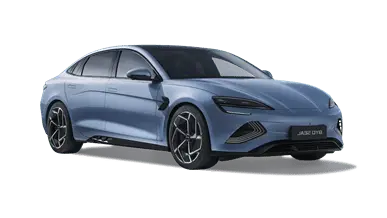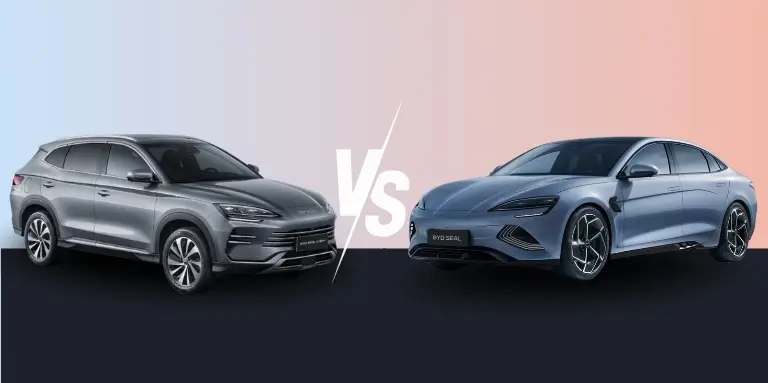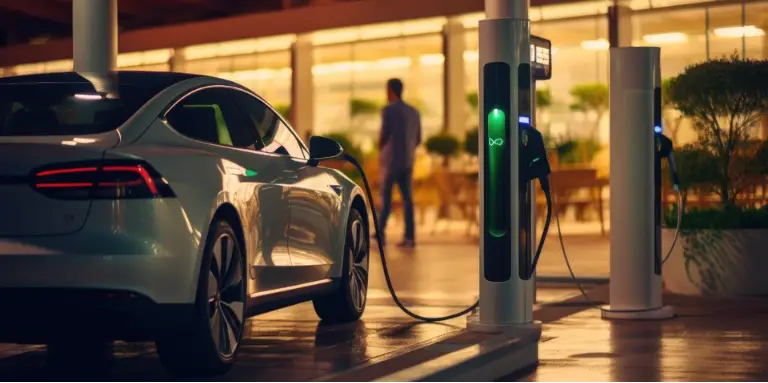Performance and autonomy BYD Seal vs BYD Seal U, which is more powerful and durable?
What engine and acceleration for the BYD Seal and BYD Seal U?
La BYD Seal stands out for its sporting performance. It is offered in two configurations: a rear-wheel drive (RWD) version with a power output of 230 kW (313 bhp) and acceleration from 0 to 100 km/h in 5.9 seconds, and an all-wheel drive (AWD) version developing 390 kW (530 bhp), capable of reaching 100 km/h in just 3.8 seconds. Both versions are limited to a maximum speed of 180 km/h, underlining the car's sporting and electric premium credentials.
For its part, the BYD Seal U takes a more moderate approach. Equipped with a permanent magnet synchronous motor delivering 160 kW (218 bhp), it offers torque of up to 330 Nm in its Design version. Acceleration from 0 to 100 km/h is 9.6 seconds for this version, with a top speed of 175 km/h. This performance, while more modest than that of the Seal, reflects its positioning as a versatile family SUV.
What is the range and recharging capacity depending on the version?
La BYD Seal offers impressive autonomy thanks to its battery 82.5 kWh. The rear-wheel drive version has a WLTP range of up to 570 km, while the all-wheel drive version has a range of around 520 km. In terms of recharging, it accepts a maximum DC output of 150 kW, enabling it to go from 10 % to 80 % in around 37 minutes. At alternating current (AC)It supports up to 11 kW, requiring around 8 hours to fully recharge.
Le BYD Seal U is available with two battery capacities: a Comfort version with a 71.8 kWh battery offering around 420 km of WLTP range, and a Design version with an 87 kWh battery providing up to 500 km. For fast charging, it tolerates up to 140 kW in DC, reducing the time needed to go from 10 % to 80 % to around 43 minutes. In AC, the maximum power remains standard at 11 kW, requiring between 7.5 hours and 9.20 hours for a full recharge depending on the battery capacity.
Comfort and practicality: BYD Seal vs BYD Seal U, which car is better for everyday use?
Interior space, boot volume and comfort features
In terms of comfort and practicality, the BYD Seal and BYD Seal U meet different needs. The BYD Seal, as a sports saloon, offers an elegant and well-equipped interior, but its space is optimised for more personal or urban use. Its 400-litre boot is sufficient for everyday needs, but is still limited compared with that of the Seal U. It places greater emphasis on a dynamic driving experience and refined design.
The BYD Seal U, on the other hand, excels in the field of family comfort and versatility. With a boot volume of up to 552 litres (1,440 litres with the seats folded down), it's much more practical for trips or bulky shopping.
Its spacious cabin offers a flat floor and excellent legroom for rear passengers, as well as a panoramic roof that enhances the feeling of space. Heated, ventilated and electrically adjustable front seats, available on top-of-the-range versions, add a touch of luxury. What's more, its modern multimedia system with up to 15.6-inch touchscreen and Apple CarPlay/Android Auto compatibility enhances its appeal for practical, connected everyday use.
Technology and equipment : BYD Seal vs BYD Seal U, which is the most innovative?
In terms of technology and equipment, the BYD Seal and BYD Seal U are both positioned as innovative vehicles, but with slightly different orientations. The BYD Seal, being a sports saloon, focuses on technologies linked to performance and the dynamic driving experience. It benefits from the e-Platform 3.0 platform, optimised for electric vehicles, which improves energy efficiency and performance.
Meanwhile, the BYD Seal U features a smart cockpit with a 15.6-inch rotating screen, offering advanced voice recognition and compatibility with Android Auto and Apple CarPlay. Both models are equipped with the Blade LFP battery, renowned for its safety and performance, but the Seal U offers larger battery options of up to 87 kWh.
In terms of driver assistance, the Seal U stands out with advanced systems such as Intelligent Cruise Control (ICC) and Rear Cross Traffic Alert (RCTA). Although both vehicles are technologically advanced, the Seal U appears to have a slight advantage in terms of comfort and driver assistance features, while the Seal could be considered more innovative in terms of electrical performance.
Price and value for money: BYD Seal vs BYD Seal U, which version is more cost-effective?
The BYD Seal and BYD Seal U are positioned differently in terms of price and value for money, catering for different needs. The BYD Seal, in its Design version with a range of 570 km, is priced at €46,990, a competitive price for a well-equipped electric sports saloon offering dynamic performance and a long range. It is aimed primarily at buyers looking for a premium vehicle with a focus on style and performance.
As a versatile family SUV, the BYD Seal U is more affordable. The Comfort version starts at €41,890, while the Design version with an 87 kWh battery and a range of 500 km is available for €45,390 (or even less, with discounts as low as €42,666). With its generous interior space, modern equipment and 6-year or 150,000 km warranty, it offers excellent value for money for families or those looking for a practical everyday vehicle.
So, while the BYD Seal impresses with its performance and range, the Seal U appears to be the most cost-effective thanks to its competitive price and versatility, particularly for buyers who need a spacious, well-equipped SUV.
Which BYD model is ideal for professionals: Seal or Seal U?
The choice between the BYD Seal and the Seal U for professional use will largely depend on your specific needs. The BYD Seal, a sporty saloon, is particularly suited to professionals looking for a stylish, high-performance car for their travels. Its comfortable range of up to 570 km makes it a good choice for sales people or executives who regularly make long journeys. What's more, its refined design and on-board technologies project a modern, dynamic image.
If your business requires more space and versatility, the BYD Seal U will be more appropriate. This family SUV offers generous boot space and a spacious cabin, ideal for transporting equipment, samples or colleagues. Its modularity and comfort make it ideal for professionals who need a multi-purpose vehicle for a variety of missions. What's more, its safety features and driving aids make it a reassuring choice for drivers who cover a lot of miles. To make the best choice, weigh up the importance of image, comfort, space and performance for your business.
See also our article :
Comparison table: BYD Seal vs BYD Seal U at a glance
| Features | BYD Seal | BYD Seal U |
|---|---|---|
| Type of vehicle | Sporty saloon | Family SUV |
| Motorisation | 230 kW (313 bhp) RWD or 390 kW (530 bhp) AWD | 160 kW (218 bhp) |
| Acceleration 0-100 km/h | 5.9 s (RWD) / 3.8 s (AWD) | 9,6 s |
| Maximum speed | 180 km/h | 175 km/h |
| Battery | 82.5 kWh | 71.8 kWh or 87 kWh |
| WLTP range | 570 km (RWD) / 520 km (AWD) | 420 km (Comfort) / 500 km (Design) |
| DC fast recharge | 150 kW | 115 kW (Comfort) / 140 kW (Design) |
| Recharge time 10-80% | 37 min | 42-43 min |
| Boot volume | 400 L | 552 L (1440 L with seats folded down) |
| Key equipment | e-Platform 3.0 platform | 15.6" rotating screen, ICC, RCTA |
| Base price | 46 990€ | 41,890 (Comfort) / €45,390 (Design) |
| Orientation | Performance and dynamism | Comfort and family versatility |

VS

Compare the BYD Seal vs BYD Seal Uin our electric car comparison tool
Verdict: BYD Seal vs BYD Seal U, which model should you choose?
Which version do you prefer, depending on how you use it (city, family, long journeys)?
The choice between the BYD Seal and the BYD Seal U largely depends on the specific needs of the user. The BYD Seal sports saloon is ideal for those who value performance and fuel efficiency.
With an acceleration from 0 to 100 km/h in 3.8 seconds for the AWD version, it is perfectly suited to drivers looking for a dynamic driving experience, whether in town or on long journeys. The BYD Seal U, on the other hand, is more suited to families and users requiring more space and versatility. Its 552-litre boot and spacious interior make it a wise choice for family trips or bulky errands.
For urban journeys, the Seal U offers better manoeuvrability thanks to its smaller turning circle and numerous cameras that make manoeuvring easier. For longer journeys, however, the Seal may be preferred for its greater fuel efficiency and longer range, up to 570 km for the RWD version. In short, if sportiness and efficiency are your priorities, opt for the Seal; if space and practicality are your priorities, the Seal U will be the better choice.
If you're interested in one of these models, contact Beev for personalised support in your choice, helping you to find the right model for you. electric car that best suits your needs and preferences.
Use the TCO simulator to calculate the total cost of ownership of your car and compare it with its internal combustion equivalent.

































